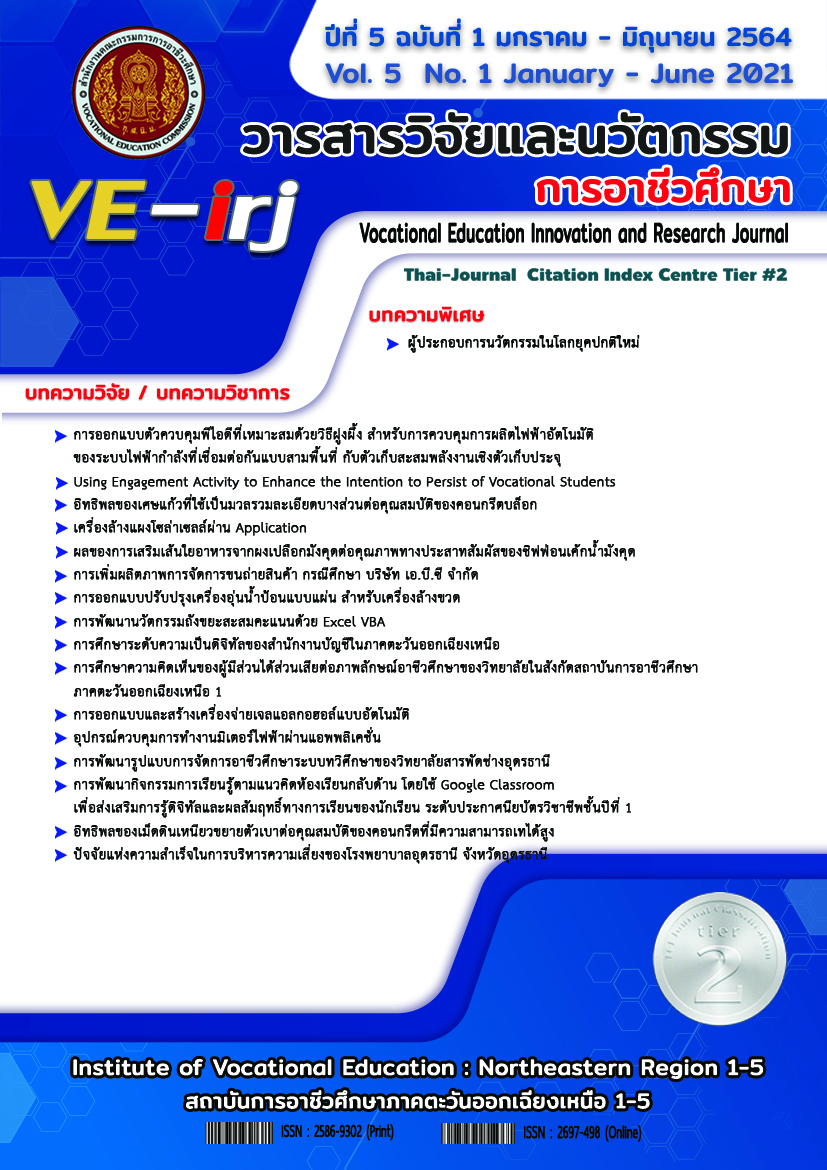การออกแบบตัวควบคุมพีไอดีที่เหมาะสมด้วยวิธีฝูงผึ้ง สำหรับการควบคุมการผลิตไฟฟ้าอัตโนมัติ ของระบบไฟฟ้ากำลังที่เชื่อมต่อกันแบบสามพื้นที่ กับตัวเก็บสะสมพลังงานเชิงตัวเก็บประจุ
Main Article Content
บทคัดย่อ
บทความวิจัยฉบับนี้นำเสนอการควบคุมการผลิตไฟฟ้าอัตโนมัติของระบบไฟฟ้ากำลัง (AGC) ที่มีการเชื่อมต่อกันแบบสามพื้นที่ ประกอบด้วยโรงไฟฟ้าพลังความร้อน โรงไฟฟ้าพลังความร้อนและโรงไฟฟ้าพลังน้ำ ระบบไฟฟ้ากำลังมีตัวเก็บสะสมพลังงานเชิงตัวเก็บประจุ (CES) โดยใช้ตัวควบคุมพีไอดีที่มีการประยุกต์ใช้วิธีฝูงผึ้ง (BA) เพื่อช่วยในการออกแบบตัวควบคุมพีไอดีให้มีความเหมาะสม และมีความคงทน วิธีฝูงผึ้งจะช่วยหาค่าอัตราขยายต่างๆ ของตัวควบคุมพีไอดี เพื่อควบคุมความถี่ของระบบไฟฟ้ากำลังให้มีการเปลี่ยนแปลงน้อยที่สุดภายใต้สภาวะที่โหลดมีการเปลี่ยนแปลง และเพื่อควบคุมการส่งจ่ายและจำหน่ายกำลังไฟฟ้าให้เพียงพอต่อความต้องการ ผลจากการจำลองแบบชี้ให้เห็นว่า ตัวควบคุมพีไอดีที่เหมาะสมกับตัวเก็บสะสมพลังงานเชิงตัวเก็บประจุจะส่งผลให้ระบบไฟฟ้ากำลังทั้งสามพื้นที่มีการดำเนินงานที่มีประสิทธิภาพสูงกว่าทั้งกรณีที่ใช้ตัวควบคุมพีไอและกรณีที่ไม่มีตัวเก็บสะสมพลังงานเชิงตัวเก็บประจุในการตอบสนองพลวัต และช่วยลดค่าผิดพลาดสมบูรณ์อินทิกรัล (IAE) ดังนั้น ตัวควบคุมพีไอดีที่เหมาะสมกับตัวเก็บสะสมพลังงานเชิงตัวเก็บประจุจะส่งผลให้ระบบไฟฟ้ากำลังมีการส่งจ่ายและจำหน่ายกำลังไฟฟ้าได้อย่างมีเสถียรภาพ
Article Details
สงวนสิทธิ์ โดย สถาบันการอาชีวศึกษาภาคตะวันออกเฉียงเหนือ 1
306 หมู่ 5 ถนนมิตรภาพ หนองคาย-อุดรธานี ตำบลโพธิ์ชัย อำเภอเมืองหนองคาย จังหวัดหนองคาย 43000
โทร 0-4241-1445,0-4241-1447
ISSN : 3027-6861 (print) ISSN : 3027-687X (online)
เอกสารอ้างอิง
J. Nanda, A. Mangla and S. Sanjay, “Some New Findings on Automatic Generation Control of an Interconnected Hydrothermal System With Conventional Controllers” IEEE Trans Energy Conversions, 21, pp.187-194, 2006.
D.K. Chaturvedi, P.S. Satsangi and P.K. Kalra, “Load frequency control: A Generalized neural network approach” Electrical Power and Energy Systems, 1999, pp.405-415.
P. Durongdumrongchai, W. Sa-Ngiamvibool, A. Aurasopon, and S. Pothiya, “Robust and optimal fuzzy logic-PID controllers design by bee algorithm for hydro-thermal system” Rev. Roum. Sci. Techn, 59, pp.193-203, 2014.
L. Amlan, P. Abhijith and A. Peer Fathima, “Three area AGC of an interconnected power system with superconducting magnetic energy storage” International Journal of Industrial Electronics and Electrical Engineering, 2, pp.54-57, 2014.
P. Durongdumrongchai, W. Khamtawee, K. Deeya, T. Kuntothom and N. Ariyapim, “Robust and Optimal FLPID Controllers Design by Bee Algorithm for AGC of Hydro-Thermal System with SMES” College of Asian Scholar Journal, 1, pp.1-9, 2019.
D. Maiti, A. Acharya, M. Chakraborty and A. Konar, “Tuning PID And PIλDδ Controllers using the Integral Time Absolute Error Criterion” International Conference on Information and Automation for Sustainability, pp.457-462, 2008.
S. Pothiya and I. Ngamroo, “Optimal fuzzy logic- based PID controller for load-frequency control including superconducting magnetic energy storage units” Energy Convers. Manage, 49, pp. 2833-2838, 2008.
J. G. Ziegler, and N.B. Nichols, “Optimum settings for Automatic controllers, Trans.ASME, 64, pp.759-768, 1942.
M. R. Djalal, M. Y. Yusuf, A. Imran and H. Setiadi, “Capacitive Energy Storage (CES) Optimization For Load Frequency Control in Micro Hydro Power Plant Using Imperialist Competitive Algorithm (ICA)” EMITTER International Journal of Engineering Technology, 5, pp. 279-297, 2017.
T. Chaiyatham and I. Ngamroo, “A bee colony optimization based-fuzzy logic-PID control design of electrolyzer for microgrid stabilization” International Journal of Innovative Computing, Information and Control, 8, pp.6049-6066, 2012.


